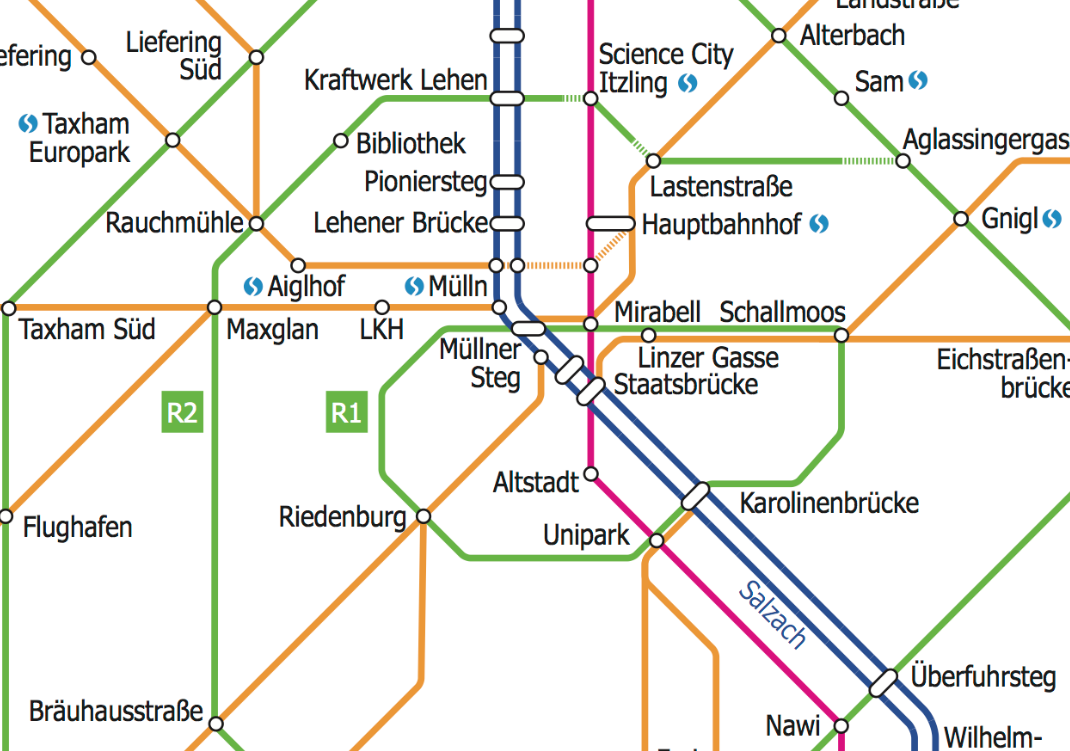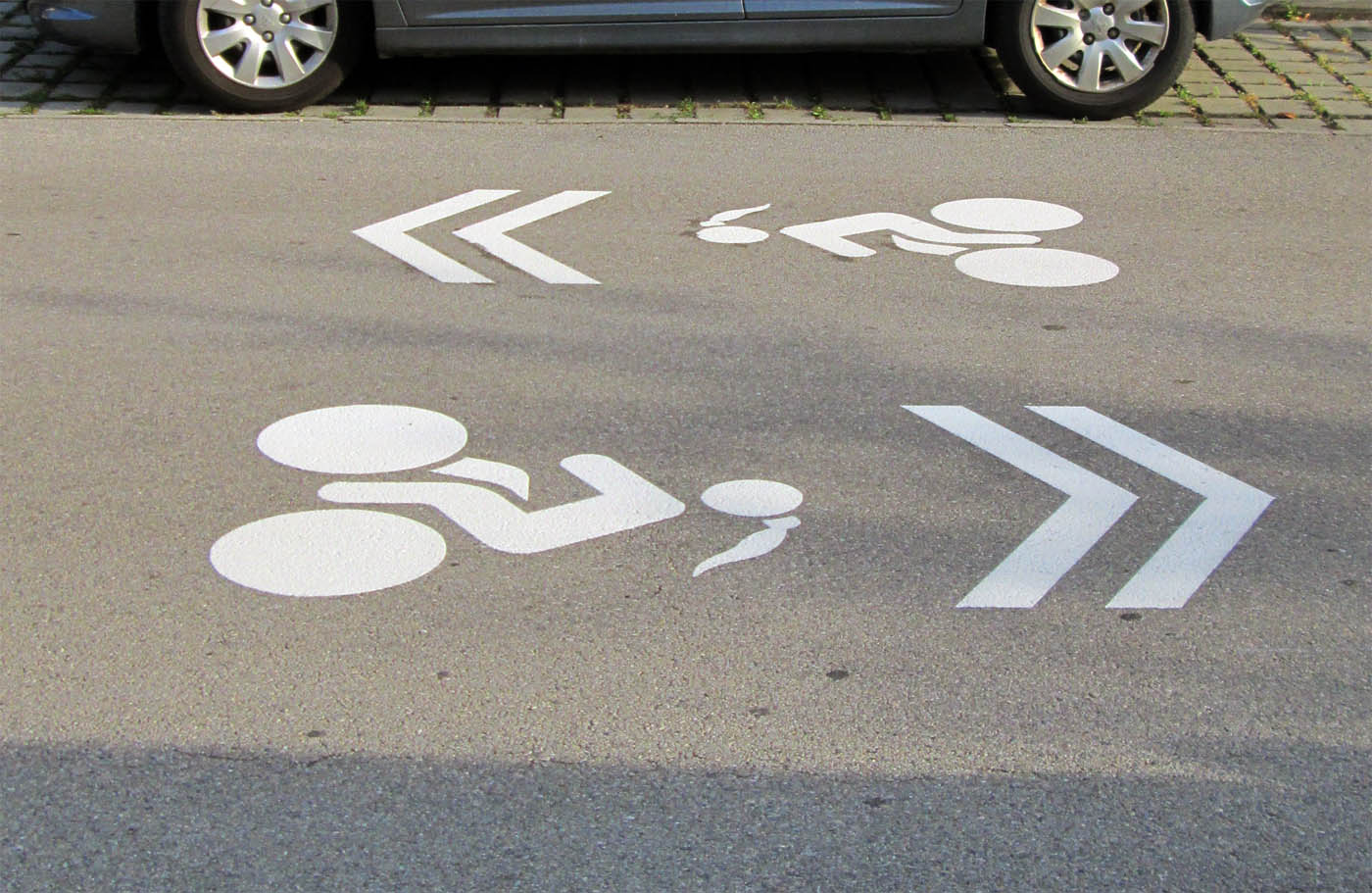New guidelines for austrian cycle planning

Current developments in traffic engineering have caused the previous standards and guidelines for road design from 2014 (RVS) to become outdated. From April 1st 2022 new standards and guidelines for cycling infrastructure are being introduced, which a number of our partners helped formulate. In this article, we will present some of the highlights.
Together, the Highway Code and the RVS guidelines make up the legal framework and planning basis for cycle infrastructure and are published by the Austrian Research Association for Road, Rail and Traffic. The goal of these guidelines, is to create cutting-edge quality standards which apply to the planning, building and operation of new traffic facilities. The planning and adaptation of all new and existing public cycle infrastructure must adhere to the RVS guidelines (03.02.13). This ensures that the recommended elements are implemented and quality standards are met.
What are the new developments in the Cycling Guidelines for 2022?
We are pleased to be able to present the most important changes in 2022: for example, that cycle planning moving forwards will more strongly consider the issue of supply and demand to better build for the future, the replacement of minimum and normed lane widths with a system of a base width plus additional space, establishment of sharrows and classification of cycle superhighways (the pinnacle of the modern bike path) and lastly, the subject of bicycle parking.
The weight of traffic should determine the width: Base-width plus additional space
One important development is the new width regulation for cycle paths. The minimum and normed width system has been replaced with a much more intuitive process for deciding the dimantions of new infrastructure. If the motorised traffic on a certain route dictates that it be accompanied by either a bike lane, multi-use lane, a segregated cycle path or a shared path, the resulting lane must be constructed based on the route hierarchy and the predicted frequency of cycle traffic. The total width of the resulting bike path is a product of the base-width, plus the necessary additional width (formaly known as the protection strip). The additional width is determined by the useage of the route the cycle path is built on.
The changes to the RVS make for much more generous and safer widths. Cycle paths should be at least 2.6m wide in order to facilitate the safe overtaking of cargobikes or bike trailers and provide enough room for two-way riding.
The full width of a cycle path (base-width plus addition) Graphic to follow when RVS is publihed.
Building where nobody cycles: The supply prerequisites
The biggest advancements have been in the criteria used to decide where to build bike lanes. The choice of when and where to develop cycle infrastructure has, until now been based on route hierarchy, motorised vehicle speeds and weight of traffic. Now the principal of supply and demand has been added to these existing criteria to improve future route planning. By taking into account possible future demand, it will be easier to treat building new routes as a matter of supply first and demand second. The weight of cycle traffic in the short term becomes a less important planning criterion and more emphasis can be put on building high quality networks.
The width of new cycle paths is determined incrementally by the following frequency of cycle traffic:
Level A: This highest priority is introduced on routes with 240 cyclists or more at rush hour. In each direction of travel, a cargobike has space to overtake a slower moving cargobike.
Level B: This level is introduced on main routes with 240 cyclists or more at rush hour and on connecting and tributary routes with 360 cyclists or more at rush hour. In each direction of travel, a regular bike has space to overtake a cargobike.
Level C: This level will be only be used on connecting and tributary routes with fewer than 360 cyclists per hour at rush hour. The width will allow one cargobike to use the cycle path.
Level D: On this lowest priority route, only regular bikes will fit on the cycle path. This level is for routes with fewer than 60 cyclists per hour at rush hour on less important connecting and tributary routes. Mixing with motoised traffic is only necessary on connecting streets.
“Sharrows” – the arrows on the road
Pictograms (Sharrows), which have already been in use for a while in other countries, have finally become anchored in the RVS. Sharrows are a road marking which combine a bicycle pictogram and double upwards-pointing arrows, which are used to make all road users particularly aware of cycle traffic on the route. They also suggest an optimal cycling distance from the cerb or from parked cars, in order to minimise the dangers of ‘dooring’ and discourage innapropriate overtaking by following vehicles. Sharrows could be optimally implemented between tram tracks for example, to encourage the use of this safer road positioning by cyclists. Sharrows cannot however, be seen as a replacement for a bike lane or other route signage.
Graphic to follow when RVS is publihed.
Passing also allowed: Opening one-way streets
Traffic flow in the one-way streets which have been opened in the opposite direction for cyclists has also been reevaluated. In the new RVS, minimum road width has been better linked to specific situational parameters and the possibility to open one-way streets with a lane width under 3.5m has been made more concrete by the introduction of regular passing places. The design of junctions for cyclists coming to and from opened one-way streets is also more clearly formulated.
Guidelines for the queen of the bike lanes – the cycle superhighway
Cycle superhighways are specific cycle routes which link important urban and rural centres over greater distances and are considered to have the highest quality infrastructure possible for cyclists. With the exception of bike-priority streets, cycle superhighways run separately from all other foot and motorised traffic. They are defined by certain characteristics such as: independent or road-parallel cycle paths, bike-priority streets or marked bike lanes. This means that any superhighway route designed to be used in both directions must have a width of at least 4m plus any additional safety separation defined by the other traffic useage of the route. Other elements which maintain the quality of the route are gradients of no more than 6%, a projected speed of 30 km/h and a road surface of either asphalt or concrete.
Graphic to follow when RVS is publihed.
Look at the ground: Navigation using symbols
Also new to the 2022 version of the RVS is the addition of road markings for navigating cycle routes. These are comprised of between two and four vertical boxes, painted with a green background and using white symbols which are painted directly onto the ground.
More room to park: The topic of bicycle parking
The chapter in the RVS concerning bicycle parking has been reexamined in detail, taking into consideration the infrastructure and space needed, improvements that can be made, short and long term parking solutions and specific parking systems.
Graphic to follow when RVS is publihed.
Preview: For the first time, the RVS cycling guidelines will be made available for free download online. This has been made possible by the Initiative of the Ministry for Climate Protection, a Radkompetenz member.
Cycling Competence Members in this article:
More articles with this member:
[crp]
Share this article:
New guidelines for austrian cycle planning
Share this article:

Current developments in traffic engineering have caused the previous standards and guidelines for road design from 2014 (RVS) to become outdated. From April 1st 2022 new standards and guidelines for cycling infrastructure are being introduced, which a number of our partners helped formulate. In this article, we will present some of the highlights.
Together, the Highway Code and the RVS guidelines make up the legal framework and planning basis for cycle infrastructure and are published by the Austrian Research Association for Road, Rail and Traffic. The goal of these guidelines, is to create cutting-edge quality standards which apply to the planning, building and operation of new traffic facilities. The planning and adaptation of all new and existing public cycle infrastructure must adhere to the RVS guidelines (03.02.13). This ensures that the recommended elements are implemented and quality standards are met.
What are the new developments in the Cycling Guidelines for 2022?
We are pleased to be able to present the most important changes in 2022: for example, that cycle planning moving forwards will more strongly consider the issue of supply and demand to better build for the future, the replacement of minimum and normed lane widths with a system of a base width plus additional space, establishment of sharrows and classification of cycle superhighways (the pinnacle of the modern bike path) and lastly, the subject of bicycle parking.
The weight of traffic should determine the width: Base-width plus additional space
One important development is the new width regulation for cycle paths. The minimum and normed width system has been replaced with a much more intuitive process for deciding the dimantions of new infrastructure. If the motorised traffic on a certain route dictates that it be accompanied by either a bike lane, multi-use lane, a segregated cycle path or a shared path, the resulting lane must be constructed based on the route hierarchy and the predicted frequency of cycle traffic. The total width of the resulting bike path is a product of the base-width, plus the necessary additional width (formaly known as the protection strip). The additional width is determined by the useage of the route the cycle path is built on.
The changes to the RVS make for much more generous and safer widths. Cycle paths should be at least 2.6m wide in order to facilitate the safe overtaking of cargobikes or bike trailers and provide enough room for two-way riding.
The full width of a cycle path (base-width plus addition) Graphic to follow when RVS is publihed.
Building where nobody cycles: The supply prerequisites
The biggest advancements have been in the criteria used to decide where to build bike lanes. The choice of when and where to develop cycle infrastructure has, until now been based on route hierarchy, motorised vehicle speeds and weight of traffic. Now the principal of supply and demand has been added to these existing criteria to improve future route planning. By taking into account possible future demand, it will be easier to treat building new routes as a matter of supply first and demand second. The weight of cycle traffic in the short term becomes a less important planning criterion and more emphasis can be put on building high quality networks.
The width of new cycle paths is determined incrementally by the following frequency of cycle traffic:
Level A: This highest priority is introduced on routes with 240 cyclists or more at rush hour. In each direction of travel, a cargobike has space to overtake a slower moving cargobike.
Level B: This level is introduced on main routes with 240 cyclists or more at rush hour and on connecting and tributary routes with 360 cyclists or more at rush hour. In each direction of travel, a regular bike has space to overtake a cargobike.
Level C: This level will be only be used on connecting and tributary routes with fewer than 360 cyclists per hour at rush hour. The width will allow one cargobike to use the cycle path.
Level D: On this lowest priority route, only regular bikes will fit on the cycle path. This level is for routes with fewer than 60 cyclists per hour at rush hour on less important connecting and tributary routes. Mixing with motoised traffic is only necessary on connecting streets.
“Sharrows” – the arrows on the road
Pictograms (Sharrows), which have already been in use for a while in other countries, have finally become anchored in the RVS. Sharrows are a road marking which combine a bicycle pictogram and double upwards-pointing arrows, which are used to make all road users particularly aware of cycle traffic on the route. They also suggest an optimal cycling distance from the cerb or from parked cars, in order to minimise the dangers of ‘dooring’ and discourage innapropriate overtaking by following vehicles. Sharrows could be optimally implemented between tram tracks for example, to encourage the use of this safer road positioning by cyclists. Sharrows cannot however, be seen as a replacement for a bike lane or other route signage.
Graphic to follow when RVS is publihed.
Passing also allowed: Opening one-way streets
Traffic flow in the one-way streets which have been opened in the opposite direction for cyclists has also been reevaluated. In the new RVS, minimum road width has been better linked to specific situational parameters and the possibility to open one-way streets with a lane width under 3.5m has been made more concrete by the introduction of regular passing places. The design of junctions for cyclists coming to and from opened one-way streets is also more clearly formulated.
Guidelines for the queen of the bike lanes – the cycle superhighway
Cycle superhighways are specific cycle routes which link important urban and rural centres over greater distances and are considered to have the highest quality infrastructure possible for cyclists. With the exception of bike-priority streets, cycle superhighways run separately from all other foot and motorised traffic. They are defined by certain characteristics such as: independent or road-parallel cycle paths, bike-priority streets or marked bike lanes. This means that any superhighway route designed to be used in both directions must have a width of at least 4m plus any additional safety separation defined by the other traffic useage of the route. Other elements which maintain the quality of the route are gradients of no more than 6%, a projected speed of 30 km/h and a road surface of either asphalt or concrete.
Graphic to follow when RVS is publihed.
Look at the ground: Navigation using symbols
Also new to the 2022 version of the RVS is the addition of road markings for navigating cycle routes. These are comprised of between two and four vertical boxes, painted with a green background and using white symbols which are painted directly onto the ground.
More room to park: The topic of bicycle parking
The chapter in the RVS concerning bicycle parking has been reexamined in detail, taking into consideration the infrastructure and space needed, improvements that can be made, short and long term parking solutions and specific parking systems.
Graphic to follow when RVS is publihed.
Preview: For the first time, the RVS cycling guidelines will be made available for free download online. This has been made possible by the Initiative of the Ministry for Climate Protection, a Radkompetenz member.
Cycling Competence Members in this article:
More articles with this member:
[crp]




